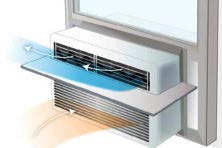Comprehensive performance tests lead to affordable methods for increasing the energy efficiency of window air conditioners.

One problem with window air conditioners is that a significant portion of the conditioned air gets recirculated back into the air conditioner.
EACH YEAR, 7.5 million window air conditioners are purchased in the United
States—more than all other home cooling equipment combined. However, window
air conditioners have low minimum efficiency standards, and air leakage
significantly reduces the equipment’s performance.
To measure the impact these products have on home energy use, researchers at
the National Renewable Energy Laboratory (NREL) studied the performance of
one 10-year-old and three new window air conditioners in a range of climates and
conditions. The testing provided unique performance data with separate performance
evaluations for cooling operation, internal air leakage, and leakage resulting from installation in a window.
NREL showed the new air conditioners’ measured performance was consistent
with their ratings, while the 10-year-old unit was not. NREL’s methods also showed
that cycling, installation, and infiltration effects can prevent window air conditioners
from achieving their rated efficiency.

Installing a diverter helps to maximize cool air flow from the air conditioner.
In addition to the performance testing, NREL developed recommendations
for manufacturers on how to improve performance at very modest cost. NREL
also published a homeowner’s guide for providing tips for better window air
conditioner installation.
NREL provided homeowners with several low-cost practical tips for improving
the operating efficiency of their windowunit air conditioners.
- Remove the accordion panels that come with the unit and replace with pieces of rigid foam insulation cut to fit between each side of the unit and the window frame. Use duct tape to secure the foam panels and prevent air leaks.
- Install foam backer rod between the sashes.
- Make a diverter of rigid foam (as shown in lower figure to the right) and install it to prevent conditioned supply air from being drawn back into the stale air return.
- Periodically clean the intake and exhaust grills on the inside and outside of the unit.
- Remove the unit from the window when the cooling season is over.
Lessons Learned:
- Installation, infiltration, and cycling losses may prevent window air conditioners from achieving their rated performance.
- There is significant potential for degradation of the window units with time, because proper maintenance is difficult.
- A poorly installed window air conditioner can increase whole-house air leakage by 10%. Air sealing around the air conditioner is critical for best performance.
- Air recirculation can reduce the overall efficiency of the air conditioner by 10%.
- Homeowners can follow NRELrecommended installation procedures to reduce energy consumption by up to 10%, which can save up to $30 a year in utility bills. This can be done with a onetime cost of around $15 using materials from home improvement stores. This saves enough energy to pay for most air conditioners over their lifetime.
Source: http://bit.ly/efficient_ac
| NREL estimates its window air conditioner recommendations will result in 5% to 10% cooling energy savings—enough to pay for the air conditioner over its lifetime. If all window air conditioners were improved in this way, the nation’s energy use could be reduced by 40 trillion Btu per year, saving consumers $400 million each year. |








You can make an air diverter out of Coroplast – or Corrugated Plastic that works really well too.
Makes it much easier to get by with a little 5000btu unit